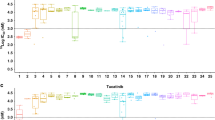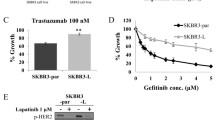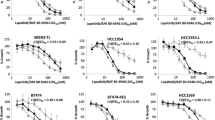Summary
Treatment response rates to current anticancer therapies for HER2 overexpressing breast cancer are limited and are associated with severe adverse drug reactions. Tyrosine kinases perform crucial roles in cellular processes by mediating cell signalling cascades. Ibrutinib is a recently approved Tyrosine Kinase Inhibitor (TKI) that has been shown be an effective therapeutic option for HER2 overexpressing breast cancer. The molecular mechanisms, pathways, or genes that are modulated by ibrutinib and the mechanism of action of ibrutinib in HER2 overexpressing breast cancer remain obscure. In this study, we have performed a kinome array analysis of ibrutinib treatment in two HER2 overexpressing breast cancer cell lines. Our analysis shows that ibrutinib induces changes in nuclear morphology and causes apoptosis via caspase-dependent extrinsic apoptosis pathway with the activation of caspases-8, caspase-3, and cleavage of PARP1. We further show that phosphorylated STAT3Y705 is upregulated and phosphorylated p21T145 is downregulated upon ibrutinib treatment. We propose that STAT3 upregulation is a passive response as a result of induction of DNA damage and downregulation of phosphorylated p21 is promoting cell cycle arrest and apoptosis in the two HER2 overexpressing cell lines. These results suggest that inhibitors of STAT3 phosphorylation may be potential options for combination therapy to help increase the efficacy of ibrutinib against HER2-overexpressing tumors.








Similar content being viewed by others

References
DeSantis C, Ma J, Bryan L, Jemal A (2014) Breast cancer statistics, 2013. CA Cancer J Clin 64(1):52–62. https://doi.org/10.3322/caac.21203
Irvin W Jr, Muss HB, Mayer DK (2011) Symptom management in metastatic breast cancer. Oncologist 16(9):1203–1214. https://doi.org/10.1634/theoncologist.2011-0159
Lluch A, Alvarez I, Munoz M, Segui MA, Tusquets I, Garcia-Estevez L (2014) Treatment innovations for metastatic breast cancer: nanoparticle albumin-bound (NAB) technology targeted to tumors. Crit Rev Oncol Hematol 89(1):62–72. https://doi.org/10.1016/j.critrevonc.2013.08.001
O'Sullivan CC, Smith KL (2014) Therapeutic considerations in treating HER2-positive metastatic breast Cancer. Curr Breast Cancer Rep 6(3):169–182. https://doi.org/10.1007/s12609-014-0155-y
Jahanzeb M (2008) Adjuvant trastuzumab therapy for HER2-positive breast cancer. Clin Breast Cancer 8(4):324–333. https://doi.org/10.3816/CBC.2008.n.037
Slamon DJ, Leyland-Jones B, Shak S, Fuchs H, Paton V, Bajamonde A, Fleming T, Eiermann W, Wolter J, Pegram M, Baselga J, Norton L (2001) Use of chemotherapy plus a monoclonal antibody against HER2 for metastatic breast cancer that overexpresses HER2. N Engl J Med 344(11):783–792. https://doi.org/10.1056/NEJM200103153441101
Harris LN, You F, Schnitt SJ, Witkiewicz A, Lu X, Sgroi D, Ryan PD, Come SE, Burstein HJ, Lesnikoski BA, Kamma M, Friedman PN, Gelman R, Iglehart JD, Winer EP (2007) Predictors of resistance to preoperative trastuzumab and vinorelbine for HER2-positive early breast cancer. Clin. Cancer Res 13(4):1198–1207. https://doi.org/10.1158/1078-0432.CCR-06-1304
Wolff AC, Hammond ME, Schwartz JN, Hagerty KL, Allred DC, Cote RJ, Dowsett M, Fitzgibbons PL, Hanna WM, Langer A, McShane LM, Paik S, Pegram MD, Perez EA, Press MF, Rhodes A, Sturgeon C, Taube SE, Tubbs R, Vance GH, van de Vijver M, Wheeler TM, Hayes DF, American Society of Clinical Oncology/College of American P (2007) American Society of Clinical Oncology/College of American Pathologists guideline recommendations for human epidermal growth factor receptor 2 testing in breast cancer. Arch Pathol Lab Med 131 (1):18–43. doi:https://doi.org/10.1043/1543-2165(2007)131[18:ASOCCO]2.0.CO;2
Lee-Hoeflich ST, Crocker L, Yao E, Pham T, Munroe X, Hoeflich KP, Sliwkowski MX, Stern HM (2008) A central role for HER3 in HER2-amplified breast cancer: implications for targeted therapy. Cancer Res 68(14):5878–5887. https://doi.org/10.1158/0008-5472.CAN-08-0380
Kruser TJ, Wheeler DL (2010) Mechanisms of resistance to HER family targeting antibodies. Exp Cell Res 316(7):1083–1100. https://doi.org/10.1016/j.yexcr.2010.01.009
Tang J, Aittokallio T (2014) Network pharmacology strategies toward multi-target anticancer therapies: from computational models to experimental design principles. Curr Pharm Des 20(1):23–36
Tang J, Karhinen L, Xu T, Szwajda A, Yadav B, Wennerberg K, Aittokallio T (2013) Target inhibition networks: predicting selective combinations of druggable targets to block cancer survival pathways. PLoS Comput Biol 9(9):e1003226. https://doi.org/10.1371/journal.pcbi.1003226
Zhang J, Yang PL, Gray NS (2009) Targeting cancer with small molecule kinase inhibitors. Nat Rev Cancer 9(1):28–39. https://doi.org/10.1038/nrc2559
Paul MK, Mukhopadhyay AK (2004) Tyrosine kinase - role and significance in Cancer. Int J Med Sci 1(2):101–115
Davis MI, Hunt JP, Herrgard S, Ciceri P, Wodicka LM, Pallares G, Hocker M, Treiber DK, Zarrinkar PP (2011) Comprehensive analysis of kinase inhibitor selectivity. Nat Biotechnol 29(11):1046–1051. https://doi.org/10.1038/nbt.1990
Mundhenke C, Strauss A, Schem C (2009) Significance of tyrosine kinase inhibitors in the treatment of metastatic breast Cancer. Breast Care (Basel) 4(6):373–378. https://doi.org/10.1159/000261705
Honigberg LA, Smith AM, Sirisawad M, Verner E, Loury D, Chang B, Li S, Pan Z, Thamm DH, Miller RA (2010) The Bruton tyrosine kinase inhibitor PCI-32765 blocks B-cell activation and is efficacious in models of autoimmune disease and B-cell malignancy. Proc Natl Acad Sci 107(29):13075–13080
Hendriks RW, Yuvaraj S, Kil LP (2014) Targeting Bruton's tyrosine kinase in B cell malignancies. Nat Rev Cancer 14(4):219–232. https://doi.org/10.1038/nrc3702
Eifert C, Wang X, Kokabee L, Kourtidis A, Jain R, Gerdes MJ, Conklin DS (2013) A novel isoform of the B cell tyrosine kinase BTK protects breast cancer cells from apoptosis. Genes Chromosom Cancer 52(10):961–975. https://doi.org/10.1002/gcc.22091
Grabinski N, Ewald F (2014) Ibrutinib (ImbruvicaTM) potently inhibits ErbB receptor phosphorylation and cell viability of ErbB2-positive breast cancer cells. Investig New Drugs 32(6):1096–1104. https://doi.org/10.1007/s10637-014-0141-2
Sagiv-Barfi I, Kohrt HE, Czerwinski DK, Ng PP, Chang BY, Levy R (2015) Therapeutic antitumor immunity by checkpoint blockade is enhanced by ibrutinib, an inhibitor of both BTK and ITK. Proc Natl Acad Sci U S A 112(9):E966–E972. https://doi.org/10.1073/pnas.1500712112
Chen J, Kinoshita T, Sukbuntherng J, Chang BY, Elias L (2016) Ibrutinib inhibits ERBB receptor tyrosine kinases and HER2-amplified breast Cancer cell growth. Mol Cancer Ther 15(12):2835–2844. https://doi.org/10.1158/1535-7163.MCT-15-0923
Wang X, Wong J, Sevinsky CJ, Kokabee L, Khan F, Sun Y, Conklin DS (2016) Bruton's tyrosine kinase inhibitors prevent therapeutic escape in breast Cancer cells. Mol Cancer Ther 15(9):2198–2208. https://doi.org/10.1158/1535-7163.MCT-15-0813
Looi CY, Arya A, Cheah FK, Muharram B, Leong KH, Mohamad K, Wong WF, Rai N, Mustafa MR (2013) Induction of apoptosis in human breast cancer cells via caspase pathway by vernodalin isolated from Centratherum anthelminticum (L.) seeds. PLoS One 8(2):e56643. https://doi.org/10.1371/journal.pone.0056643
Riss TL, Moravec RA, Niles AL, Duellman S, Benink HA, Worzella TJ, Minor L (2004) Cell viability assays. In: Sittampalam GS, Coussens NP, Brimacombe K et al. (eds) Assay Guidance Manual. Bethesda (MD),
Wang JD, Chen XY, Ji KW, Tao F (2016) Targeting Btk with ibrutinib inhibit gastric carcinoma cells growth. Am J Transl Res 8(7):3003–3012
Smith SE, Mellor P, Ward AK, Kendall S, McDonald M, Vizeacoumar FS, Vizeacoumar FJ, Napper S, Anderson DH (2017) Molecular characterization of breast cancer cell lines through multiple omic approaches. Breast Cancer Res 19(1):65. https://doi.org/10.1186/s13058-017-0855-0
Trost B, Arsenault R, Griebel P, Napper S, Kusalik A (2013) DAPPLE: a pipeline for the homology-based prediction of phosphorylation sites. Bioinformatics 29(13):1693–1695. https://doi.org/10.1093/bioinformatics/btt265
Baine MJ, Chakraborty S, Smith LM, Mallya K, Sasson AR, Brand RE, Batra SK (2011) Transcriptional profiling of peripheral blood mononuclear cells in pancreatic cancer patients identifies novel genes with potential diagnostic utility. PLoS One 6(2):e17014. https://doi.org/10.1371/journal.pone.0017014
Dhanasekaran SM, Barrette TR, Ghosh D, Shah R, Varambally S, Kurachi K, Pienta KJ, Rubin MA, Chinnaiyan AM (2001) Delineation of prognostic biomarkers in prostate cancer. Nature 412(6849):822–826. https://doi.org/10.1038/35090585
Twine NC, Stover JA, Marshall B, Dukart G, Hidalgo M, Stadler W, Logan T, Dutcher J, Hudes G, Dorner AJ, Slonim DK, Trepicchio WL, Burczynski ME (2003) Disease-associated expression profiles in peripheral blood mononuclear cells from patients with advanced renal cell carcinoma. Cancer Res 63(18):6069–6075
Jalal S, Arsenault R, Potter AA, Babiuk LA, Griebel PJ, Napper S (2009) Genome to kinome: species-specific peptide arrays for kinome analysis. Sci Signal 2(54):pl1. https://doi.org/10.1126/scisignal.254pl1
Trost B, Kindrachuk J, Maattanen P, Napper S, Kusalik A (2013) PIIKA 2: an expanded, web-based platform for analysis of kinome microarray data. PLoS One 8(11):e80837. https://doi.org/10.1371/journal.pone.0080837
Li Y, Arsenault RJ, Trost B, Slind J, Griebel PJ, Napper S, Kusalik A (2012) A systematic approach for analysis of peptide array kinome data. Sci Signal 5 (220):pl2. https://doi.org/10.1126/scisignal.2002429
Pathan M, Keerthikumar S, Ang CS, Gangoda L, Quek CY, Williamson NA, Mouradov D, Sieber OM, Simpson RJ, Salim A, Bacic A, Hill AF, Stroud DA, Ryan MT, Agbinya JI, Mariadason JM, Burgess AW, Mathivanan S (2015) FunRich: an open access standalone functional enrichment and interaction network analysis tool. Proteomics 15(15):2597–2601. https://doi.org/10.1002/pmic.201400515
Lynn DJ, Winsor GL, Chan C, Richard N, Laird MR, Barsky A, Gardy JL, Roche FM, Chan TH, Shah N, Lo R, Naseer M, Que J, Yau M, Acab M, Tulpan D, Whiteside MD, Chikatamarla A, Mah B, Munzner T, Hokamp K, Hancock RE, Brinkman FS (2008) InnateDB: facilitating systems-level analyses of the mammalian innate immune response. Mol Syst Biol 4:218. https://doi.org/10.1038/msb.2008.55
Luo W, Pant G, Bhavnasi YK, Blanchard SG Jr, Brouwer C (2017) Pathview web: user friendly pathway visualization and data integration. Nucleic Acids Res 45(W1):W501–W508. https://doi.org/10.1093/nar/gkx372
Larionov AA (2018) Current therapies for human epidermal growth factor receptor 2-positive metastatic breast Cancer patients. Front Oncol 8:89. https://doi.org/10.3389/fonc.2018.00089
Wang A, Yan XE, Wu H, Wang W, Hu C, Chen C, Zhao Z, Zhao P, Li X, Wang L, Wang B, Ye Z, Wang J, Wang C, Zhang W, Gray NS, Weisberg EL, Chen L, Liu J, Yun CH, Liu Q (2016) Ibrutinib targets mutant-EGFR kinase with a distinct binding conformation. Oncotarget 7(43):69760–69769. https://doi.org/10.18632/oncotarget.11951
Ko HL, Ren EC (2012) Functional aspects of PARP1 in DNA repair and transcription. Biomolecules 2(4):524–548. https://doi.org/10.3390/biom2040524
Carpenter RL, Lo HW (2014) STAT3 target genes relevant to human cancers. Cancers (Basel) 6(2):897–925. https://doi.org/10.3390/cancers6020897
Timofeeva OA, Tarasova NI, Zhang X, Chasovskikh S, Cheema AK, Wang H, Brown ML, Dritschilo A (2013) STAT3 suppresses transcription of proapoptotic genes in cancer cells with the involvement of its N-terminal domain. Proc Natl Acad Sci U S A 110(4):1267–1272. https://doi.org/10.1073/pnas.1211805110
de la Iglesia N, Konopka G, Puram SV, Chan JA, Bachoo RM, You MJ, Levy DE, Depinho RA, Bonni A (2008) Identification of a PTEN-regulated STAT3 brain tumor suppressor pathway. Genes Dev 22(4):449–462. https://doi.org/10.1101/gad.1606508
Musteanu M, Blaas L, Mair M, Schlederer M, Bilban M, Tauber S, Esterbauer H, Mueller M, Casanova E, Kenner L, Poli V, Eferl R (2010) Stat3 is a negative regulator of intestinal tumor progression in Apc(Min) mice. Gastroenterology 138 (3):1003-1011 e1001-1005. https://doi.org/10.1053/j.gastro.2009.11.049
Schneller D, Machat G, Sousek A, Proell V, van Zijl F, Zulehner G, Huber H, Mair M, Muellner MK, Nijman SM, Eferl R, Moriggl R, Mikulits W (2011) p19(ARF) /p14(ARF) controls oncogenic functions of signal transducer and activator of transcription 3 in hepatocellular carcinoma. Hepatology 54(1):164–172. https://doi.org/10.1002/hep.24329
Wang H, Lafdil F, Wang L, Park O, Yin S, Niu J, Miller AM, Sun Z, Gao B (2011) Hepatoprotective versus oncogenic functions of STAT3 in liver tumorigenesis. Am J Pathol 179(2):714–724. https://doi.org/10.1016/j.ajpath.2011.05.005
Zhang HF, Lai R (2014) STAT3 in Cancer-friend or foe? Cancers (Basel) 6(3):1408–1440. https://doi.org/10.3390/cancers6031408
Yun UJ, Park SE, Jo YS, Kim J, Shin DY (2012) DNA damage induces the IL-6/STAT3 signaling pathway, which has anti-senescence and growth-promoting functions in human tumors. Cancer Lett 323(2):155–160. https://doi.org/10.1016/j.canlet.2012.04.003
Gottifredi V, McKinney K, Poyurovsky MV, Prives C (2004) Decreased p21 levels are required for efficient restart of DNA synthesis after S phase block. J Biol Chem 279(7):5802–5810. https://doi.org/10.1074/jbc.M310373200
Karimian A, Ahmadi Y, Yousefi B (2016) Multiple functions of p21 in cell cycle, apoptosis and transcriptional regulation after DNA damage. DNA Repair (Amst) 42:63–71. https://doi.org/10.1016/j.dnarep.2016.04.008
Deng T, Yan G, Song X, Xie L, Zhou Y, Li J, Hu X, Li Z, Hu J, Zhang Y, Zhang H, Sun Y, Feng P, Wei D, Hu B, Liu J, Tan W, Ye M (2018) Deubiquitylation and stabilization of p21 by USP11 is critical for cell-cycle progression and DNA damage responses. Proc Natl Acad Sci U S A 115(18):4678–4683. https://doi.org/10.1073/pnas.1714938115
Child ES, Mann DJ (2006) The intricacies of p21 phosphorylation: protein/protein interactions, subcellular localization and stability. Cell Cycle 5(12):1313–1319. https://doi.org/10.4161/cc.5.12.2863
Gartel AL, Tyner AL (2002) The role of the cyclin-dependent kinase inhibitor p21 in apoptosis 1 supported in part by NIH grant R01 DK56283 (to ALT) for the p21 research and campus research board and Illinois Department of Public Health penny Severns breast and cervical Cancer grants (to ALG). 1. Mol Cancer Ther 1(8):639–649
Fan Y, Borowsky AD, Weiss RH (2003) An antisense Oligodeoxynucleotide to p21Waf1/Cip1 causes apoptosis in human breast Cancer Cells1. Mol Cancer Ther 2(8):773–782
Stewart ZA, Mays D, Pietenpol JA (1999) Defective G1-S cell cycle checkpoint function sensitizes cells to microtubule inhibitor-induced apoptosis. Cancer Res 59(15):3831–3837
Waldman T, Lengauer C, Kinzler KW, Vogelstein B (1996) Uncoupling of S phase and mitosis induced by anticancer agents in cells lacking p21. Nature 381(6584):713–716
Weiss RH (2003) p21Waf1/Cip1 as a therapeutic target in breast and other cancers. Cancer Cell 4(6):425–429
Gartel AL, Tyner AL (2002) The role of the cyclin-dependent kinase inhibitor p21 in apoptosis. Mol Cancer Ther 1(8):639–649
Lin L, Hutzen B, Zuo M, Ball S, Deangelis S, Foust E, Pandit B, Ihnat MA, Shenoy SS, Kulp S, Li PK, Li C, Fuchs J, Lin J (2010) Novel STAT3 phosphorylation inhibitors exhibit potent growth-suppressive activity in pancreatic and breast cancer cells. Cancer Res 70(6):2445–2454. https://doi.org/10.1158/0008-5472.CAN-09-2468
Sonnenblick A, Brohée S, Fumagalli D, Vincent D, Venet D, Ignatiadis M, Salgado R, Van den Eynden G, Rothé F, Desmedt C (2015) Constitutive phosphorylated STAT3-associated gene signature is predictive for trastuzumab resistance in primary HER2-positive breast cancer. BMC Med 13(1):177
Timofeeva OA, Tarasova NI, Zhang X, Chasovskikh S, Cheema AK, Wang H, Brown ML, Dritschilo A (2013) STAT3 suppresses transcription of proapoptotic genes in cancer cells with the involvement of its N-terminal domain. Proc Natl Acad Sci 110(4):1267–1272
Funding
The work was supported by the College of Pharmacy and Nutrition, University of Saskatchewan, Canada and an NSERC grant to MKS (417652).
Author information
Authors and Affiliations
Corresponding author
Ethics declarations
Conflict of interest
All authors declare that they have no conflict of interest.
Ethical approval
This article does not contain any studies with human participants or animals performed by any of the authors.
Informed consent
For this type of study, formal consent is not required.
Additional information
Publisher’s note
Springer Nature remains neutral with regard to jurisdictional claims in published maps and institutional affiliations.
Allan Boyao Yang is awardee of an NSERC Undergraduate Student Research Awards (USRA)
Electronic supplementary material
Supplementary Figure S1a
The frequency and distribution of DEPs in different cellular pathways based on gene ontology analyses: (A) biochemical processes, (B) molecular function, and (C) subcellular compartments in BT474 after Ibrutinib treatment. (PPTX 2897 kb)
Supplementary Figure S1b
The frequency and distribution of DEPs in different cellular pathways based on gene ontology analyses: (A) biochemical processes, (B) molecular function, and (C) subcellular compartments in SKBR3 after Ibrutinib treatment. (PPTX 2774 kb)
Supplementary Figure S2a
The frequency and distribution of DEPs in different pathways based on InnateDB in BT474. (PPTX 1120 kb)
Supplementary Figure S2b
The frequency and distribution of DEPs in different pathways based on InnateDB in SKBR3. (PPTX 1101 kb)
Rights and permissions
About this article
Cite this article
Prabaharan, C.B., Yang, A.B., Chidambaram, D. et al. Ibrutinib as a potential therapeutic option for HER2 overexpressing breast cancer – the role of STAT3 and p21. Invest New Drugs 38, 909–921 (2020). https://doi.org/10.1007/s10637-019-00837-w
Received:
Accepted:
Published:
Issue Date:
DOI: https://doi.org/10.1007/s10637-019-00837-w



